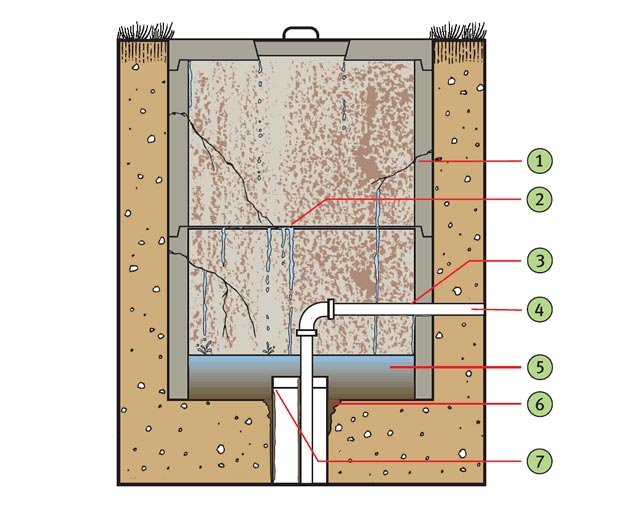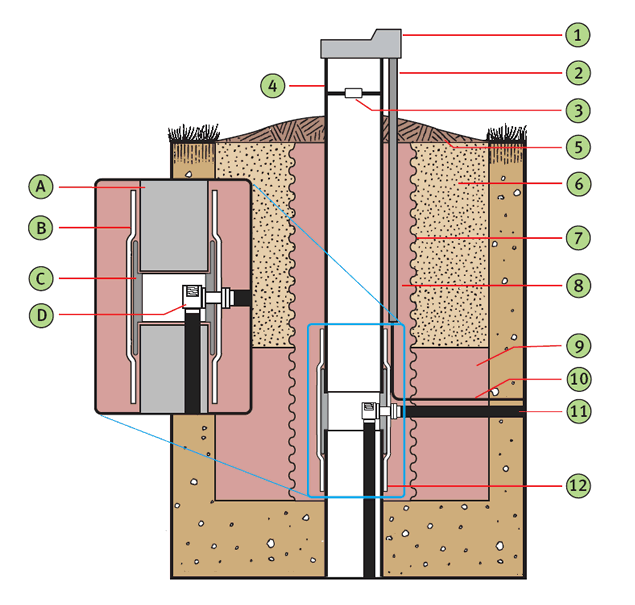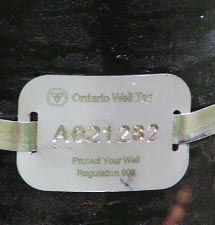Well Upgrades
![]()
You may need to upgrade and improve your well if you have any type of below grade pit or if you are unsure where your well is located.
![]()
SERVICE: Well Busters can extend your well casing, install a pitless adapter and transform your old well pit into a perfectly sealed, highly secure well that meets the Ministry of the Environment’s (MOE) current well construction guidelines.
EXPLANATION: Wells installed in Ontario prior to 1990 were permitted to be constructed with well pits. A high proportion of wells in Ontario are therefore sub-standard according to current regulations and are susceptible to contamination from coliform bacteria and other pollutants. MOE well records confirm that 1000’s of Ontario’s wells have well pits. Moreover, many of them are reasonably old (> 20 years). To reduce risk of contamination and ensure water supplies are protected, these wells require upgrades.
What’s wrong with having a well pit?

1. Cracked cement tiles. (cement tiles often crack or degrade with age – surface water, foreign
![]() materials and contaminants can enter the pit)
materials and contaminants can enter the pit)
2. Construction joints in tiles, stones or bricks that are not properly grouted. (also permit entry of
![]() surface water into well pit)
surface water into well pit)
3. Water line passages are often not sealed (additional pathway for surface water).
4. Water lines should be sealed inside and out of the well pit.
5. Surface water, foreign materials and contaminants often pool in the bottom of well pits.
6. Poor grouting of well casing (sealing of spaces adjacent to casing) allows direct passage of>
![]() surface water and contaminants into your groundwater.
surface water and contaminants into your groundwater.
7. Well seals, usually including an air vent, do a poor job of preventing surface water and contaminants
![]() from entering your well (this is typically the most critical point where contaminants may enter
from entering your well (this is typically the most critical point where contaminants may enter
![]() your well)
your well)
What does a typical well upgrade service include?
![]() Entry to well pit and removal of existing equipment (seals removed, lines/submersible pump
Entry to well pit and removal of existing equipment (seals removed, lines/submersible pump
![]() are removed);
are removed);
![]() Installation of a commercially manufactured well coupling (fabricated device with CSA approved
Installation of a commercially manufactured well coupling (fabricated device with CSA approved
![]() design) or steel weld coupling onto existing casing;
design) or steel weld coupling onto existing casing;
![]() Installation of a suitable brass pitless adapter into coupling/casing;
Installation of a suitable brass pitless adapter into coupling/casing;
![]() Addition of well casing to extend top of well to 40cm (16”) above ground surface;
Addition of well casing to extend top of well to 40cm (16”) above ground surface;
![]() Installation of protective collar to hold bentonite sealant
Installation of protective collar to hold bentonite sealant
![]() Re-install pumping equipment or lines;
Re-install pumping equipment or lines;
![]() Disinfect the well
Disinfect the well
![]() Install a vermin-proof well cap onto casing;
Install a vermin-proof well cap onto casing;
![]() Sealing annular spaces and bottom of well pit with sealant (i.e., bentonite clay)
Sealing annular spaces and bottom of well pit with sealant (i.e., bentonite clay)
![]() Fill remainder of well pit with sand
Fill remainder of well pit with sand
![]() Add topsoil to ensure drainage of area around well head
Add topsoil to ensure drainage of area around well head
![]() Complete two hour pumping test on your well, as required by the Ministry of the
Complete two hour pumping test on your well, as required by the Ministry of the
![]() Environment (MOE)
Environment (MOE)
![]() Affix MOE well tag to well (required by MOE)
Affix MOE well tag to well (required by MOE)
![]() Administer MOE Well Record and issue to customer and MOE
Administer MOE Well Record and issue to customer and MOE
What does an upgraded well look like — what are the improvements?

1. Vermin-proof well cap (standard method of sealing drilled wells)
2. Electrical conduits
3. Ministry of the Environment well tag (the MOE requires that contractors affix well tags to any well
![]() that has been altered or extended).
that has been altered or extended).
4. Steel casing extension (cut to size – 40 cm above ground surface)
5. Earth mound (promotes drainage away from well)
6. Sand fill placed in pit
7. 30 cm sleeve (to contain extended seal to surface)
8. Extended bentonite (annular) seal
9. Bentonite seals placed around pitless adapters, water line passages and the bottom of pit
![]() (to ensure surface water and foreign materials do not reach your well).
(to ensure surface water and foreign materials do not reach your well).
10. Electrical wire
11. Water lines
12. Commercial well coupling device (CSA/ANSI approved)
![]() (A) Steel casing – extension cut to size and inserted
(A) Steel casing – extension cut to size and inserted
![]() (B) Steel coupling – housing
(B) Steel coupling – housing
![]() (C) Food grade rubber seals
(C) Food grade rubber seals
![]() (D) Brass pitless adapter
(D) Brass pitless adapter
![]()
Well Busters and our agents always provide all required equipment, materials and personnel for any service. When the work is completed your well will meet or exceed current Ontario Water Resources Act regulations (R.R.O. 1990, Regulation 903).
Remember, Well Busters can help assess your well to help you determine if your well meets modern construction requirements and if you are at risk of drinking water contamination.

